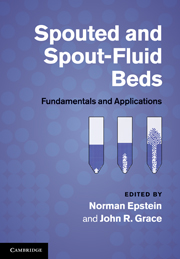Refine search
Actions for selected content:
5487 results in Thermal-fluids engineering
7 - Thermochemical Reactors
-
- Book:
- Analytic Combustion
- Published online:
- 05 June 2012
- Print publication:
- 07 March 2011, pp 134-163
-
- Chapter
- Export citation
3 - Thermodynamics of Gaseous Mixtures
-
- Book:
- Analytic Combustion
- Published online:
- 05 June 2012
- Print publication:
- 07 March 2011, pp 48-69
-
- Chapter
- Export citation
10 - Combustion of Particles and Droplets
-
- Book:
- Analytic Combustion
- Published online:
- 05 June 2012
- Print publication:
- 07 March 2011, pp 223-260
-
- Chapter
- Export citation
5 - Chemical Kinetics
-
- Book:
- Analytic Combustion
- Published online:
- 05 June 2012
- Print publication:
- 07 March 2011, pp 90-111
-
- Chapter
- Export citation
APPENDIX B - Curve-Fit Coefficients for Δhc, Tad, Kp, Cp, h, and s
-
- Book:
- Analytic Combustion
- Published online:
- 05 June 2012
- Print publication:
- 07 March 2011, pp 312-318
-
- Chapter
- Export citation
APPENDIX E - Atmospheric Data
-
- Book:
- Analytic Combustion
- Published online:
- 05 June 2012
- Print publication:
- 07 March 2011, pp 334-334
-
- Chapter
- Export citation
4 - Chemical Equilibrium
-
- Book:
- Analytic Combustion
- Published online:
- 05 June 2012
- Print publication:
- 07 March 2011, pp 70-89
-
- Chapter
- Export citation
8 - Premixed Flames
-
- Book:
- Analytic Combustion
- Published online:
- 05 June 2012
- Print publication:
- 07 March 2011, pp 164-197
-
- Chapter
- Export citation
Contents
-
- Book:
- Analytic Combustion
- Published online:
- 05 June 2012
- Print publication:
- 07 March 2011, pp vii-xii
-
- Chapter
- Export citation
1 - Introduction
-
- Book:
- Analytic Combustion
- Published online:
- 05 June 2012
- Print publication:
- 07 March 2011, pp 1-11
-
- Chapter
- Export citation
Frontmatter
-
- Book:
- Analytic Combustion
- Published online:
- 05 June 2012
- Print publication:
- 07 March 2011, pp i-vi
-
- Chapter
- Export citation
2 - Thermodynamics of a Pure Substance
-
- Book:
- Analytic Combustion
- Published online:
- 05 June 2012
- Print publication:
- 07 March 2011, pp 12-47
-
- Chapter
- Export citation
6 - Derivation of Transport Equations
-
- Book:
- Analytic Combustion
- Published online:
- 05 June 2012
- Print publication:
- 07 March 2011, pp 112-133
-
- Chapter
- Export citation
APPENDIX C - Properties of Fuels
-
- Book:
- Analytic Combustion
- Published online:
- 05 June 2012
- Print publication:
- 07 March 2011, pp 319-324
-
- Chapter
- Export citation
Index
-
- Book:
- Analytic Combustion
- Published online:
- 05 June 2012
- Print publication:
- 07 March 2011, pp 343-345
-
- Chapter
- Export citation
9 - Diffusion Flames
-
- Book:
- Analytic Combustion
- Published online:
- 05 June 2012
- Print publication:
- 07 March 2011, pp 198-222
-
- Chapter
- Export citation
11 - Combustion Applications
-
- Book:
- Analytic Combustion
- Published online:
- 05 June 2012
- Print publication:
- 07 March 2011, pp 261-294
-
- Chapter
- Export citation
Symbols and Acronyms
-
- Book:
- Analytic Combustion
- Published online:
- 05 June 2012
- Print publication:
- 07 March 2011, pp xvii-xx
-
- Chapter
- Export citation

Spouted and Spout-Fluid Beds
- Fundamentals and Applications
-
- Published online:
- 04 February 2011
- Print publication:
- 23 December 2010

Fluid-Structure Interactions
- Cross-Flow-Induced Instabilities
-
- Published online:
- 04 February 2011
- Print publication:
- 13 December 2010
